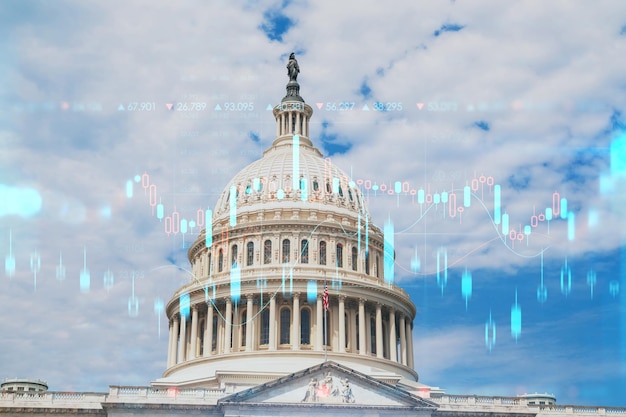Analyzing Federal Initiatives to Combat Inflation & Impact on Consumer Spending

Federal initiatives to combat inflation encompass a range of policies aimed at curbing rising prices and stabilizing the economy, with a direct impact on consumer spending habits and financial well-being in the United States.
The persistent rise in inflation has become a significant concern for households across the United States, impacting purchasing power and overall economic stability. Federal initiatives to combat inflation: analyzing the impact on consumer spending is crucial in understanding how governmental actions aim to mitigate these challenges.
Understanding the Inflation Landscape in the US
Inflation’s impact on the US economy is multifaceted, affecting everything from the cost of groceries to housing prices. Federal initiatives aim to address these challenges through various policy levers.
Key Drivers of Current Inflation
Several factors contribute to the current inflationary environment in the United States. Understanding these is essential for grasping the rationale behind federal interventions.
- Supply Chain Disruptions: Pandemic-related shutdowns and global events have led to significant disruptions in supply chains, increasing costs for businesses.
- Increased Consumer Demand: Stimulus checks and pent-up demand have fueled consumer spending, outpacing available supply in certain sectors.
- Labor Shortages: A tight labor market, with fewer workers available, has driven up wages, contributing to higher prices.
Measuring Inflation: CPI and PPI
The Consumer Price Index (CPI) and Producer Price Index (PPI) are two critical metrics used to measure inflation. CPI reflects the average change in prices paid by urban consumers for a basket of goods and services, while PPI measures the average change in selling prices received by domestic producers.

Governments often use these readings to inform policy decisions, adjusting interest rates and fiscal strategies to maintain a stable economy. Keeping a close watch on the CPI and PPI trends is vital for gauging the effectiveness of anti-inflation measures.
In summary, understanding the current inflation landscape requires a holistic view incorporating key drivers, measurement tools, and evolving government strategies.
The Federal Reserve’s Role in Managing Inflation
The Federal Reserve plays a central role in managing inflation through monetary policy. Its actions can significantly impact interest rates, credit availability, and overall economic activity.
Interest Rate Adjustments
One of the primary tools the Federal Reserve uses is adjusting the federal funds rate, which influences interest rates throughout the economy. Raising rates makes borrowing more expensive, cooling down demand and curbing inflation.
Raising interest rates is a complex decision with potential downsides, including slower economic growth and increased borrowing costs for businesses and consumers. However, economists believe it’s often a necessary measure to stabilize prices.
- Impact on Mortgages: Higher interest rates can lead to increased mortgage costs, affecting the housing market.
- Business Investments: Businesses might delay or cancel investments due to higher borrowing costs.
- Consumer Spending: Consumers may reduce spending on big-ticket items financed with credit.
Quantitative Tightening
Quantitative tightening (QT) is another tool used by the Federal Reserve. It involves reducing the Fed’s holdings of government bonds and other securities, which decreases the money supply and puts upward pressure on interest rates.
This can have similar effects to raising interest rates, but it works through a different mechanism. QT aims to unwind the extraordinary monetary stimulus provided during economic crises.

The Federal Reserve’s actions are closely watched by financial markets and economists as they play a critical role in maintaining economic stability. Understanding these tools and their potential effects is vital for assessing the impact on consumer spending.
In essence, the Federal Reserve’s strategies, particularly interest rate adjustments and quantitative tightening, are crucial for managing inflation and influencing economic behavior.
Fiscal Policy Initiatives to Combat Inflation
Beyond monetary policy, fiscal policy also plays a significant role in addressing inflation. Government spending, taxation, and debt management can all impact aggregate demand and price levels.
Government Spending and Taxation
Changes in government spending and taxation can have a direct impact on inflation. Reducing government spending or increasing taxes can lower aggregate demand, helping to cool down an overheated economy.
Conversely, increased government spending or tax cuts can stimulate demand, potentially exacerbating inflationary pressures. Policymakers must carefully weigh these trade-offs.
Here are a few examples:
- Infrastructure Spending: Investments in infrastructure can boost productivity and long-term economic growth, but they can also increase demand in the short term.
- Tax Policy: Tax increases can reduce disposable income, lowering consumer spending and investment.
- Social Programs: Government assistance programs can support demand but could also contribute to inflation if not managed carefully.
Debt Management Strategies
How the government manages its debt can also influence inflation. For example, issuing more government bonds can increase the money supply, potentially leading to higher prices.
Additionally, the level of government debt can impact investor confidence and interest rates, indirectly affecting inflation. Prudent fiscal management is key to maintaining economic stability.
Fiscal policies, especially adjustments to government spending, taxation, and debt management, are vital in the broader strategy to combat inflation and maintain economic balance.
Impact on Consumer Spending Habits
Inflation directly impacts consumer spending habits, influencing what people buy, how much they spend, and where they shop. Understanding these changes is crucial for businesses and policymakers alike.
Changes in Spending Patterns
As prices rise, consumers often adjust their spending patterns, prioritizing essential goods and services over discretionary items. This can lead to shifts in demand across different sectors of the economy.
For example, consumers may cut back on dining out, entertainment, and travel, while increasing spending on necessities like food, housing, and healthcare. These changes can have significant implications for businesses in different industries.
Here are some examples of changed spending patterns:
- Trading Down: Consumers may switch to cheaper brands or generic products.
- Delayed Purchases: Big-ticket purchases like cars and appliances may be postponed.
- Increased Discount Shopping: Consumers may seek out sales, coupons, and discounts more frequently.
Consumer Confidence and Sentiment
Inflation can also impact consumer confidence and sentiment, influencing overall economic activity. When consumers are worried about rising prices, they may become more cautious and reduce spending.
Lower consumer confidence can lead to a slowdown in economic growth, as businesses respond to weaker demand. Monitoring consumer sentiment is therefore an important part of assessing the impact of inflation.
Effectively addressing inflation and communicating transparently with the public are crucial for maintaining consumer confidence and fostering economic stability.
Strategies for Consumers to Mitigate Inflation’s Effects
While federal initiatives aim to combat inflation, consumers can also take proactive steps to mitigate its impact on their personal finances. These strategies include budgeting, saving, and making informed purchasing decisions.
Budgeting and Financial Planning
Creating a budget is one of the most effective ways to manage finances in an inflationary environment. A budget helps consumers track their income and expenses, identify areas where they can cut back, and prioritize essential spending.
Financial planning also involves setting financial goals, such as saving for retirement or a down payment on a home, and developing a strategy to achieve those goals despite rising prices.
These strategies help consumers budget and save during inflation:
- Track Expenses: Use budgeting apps or spreadsheets to monitor spending habits.
- Set Financial Goals: Establish clear financial objectives to stay motivated.
- Adjust Spending: Prioritize essential spending and cut back on non-essential items.
Saving and Investing Strategies
Saving and investing can help consumers protect their purchasing power and grow their wealth over time. High-yield savings accounts, bonds, and dividend-paying stocks are some options to consider.
It’s important to diversify investments to reduce risk and consult with a financial advisor to develop a personalized investment strategy.
Taking control of personal finances through budgeting, saving, and investing is essential for weathering inflationary pressures and building long-term financial security.
The Future Outlook: Projections and Predictions
Predicting the future path of inflation is challenging, but economists and financial analysts offer various projections and predictions based on current trends, policy actions, and economic models.
Expert Economic Forecasts
Economic forecasts from institutions like the Federal Reserve, the International Monetary Fund (IMF), and private sector firms provide insights into potential future inflation rates.
These forecasts typically consider a range of factors, including monetary policy, fiscal policy, global economic conditions, and supply chain dynamics.
Below, we will look at a couple of these points:
- Inflation Moderation: Optimistic forecasts suggest that inflation will moderate in the coming years as supply chain issues ease and demand cools down.
- Persistent Inflation: More cautious forecasts warn that inflation could remain elevated for longer due to structural factors or policy missteps.
- Uncertainty: All forecasts are subject to uncertainty, and actual outcomes may differ significantly from projections.
Long-Term Economic Implications
The long-term economic implications of current inflation depend on how effectively policymakers manage the situation. Prolonged high inflation could lead to decreased purchasing power, reduced investment, and slower economic growth.
In contrast, successful efforts to control inflation could pave the way for sustained economic prosperity. Careful monitoring and proactive policy responses are essential.
Navigating the future inflation environment requires a combination of informed decision-making, proactive financial planning, and effective government policies. By understanding the challenges and opportunities ahead, consumers, businesses, and policymakers can work together to build a more stable and prosperous economy.
| Key Point | Brief Description |
|---|---|
| 📉 Inflation Drivers | Supply chain issues, demand, and labor shortages. |
| 🏦 Fed’s Role | Manages inflation via interest rates and QT. |
| 💸 Fiscal Initiatives | Government spending, taxation, and debt strategies. |
| 🛒 Consumer Habits | Shift to essentials, delay big purchases, and seek discounts. |
Frequently Asked Questions
▼
Inflation in the US is primarily driven by supply chain disruptions, increased consumer demand from stimulus measures, and labor shortages that drive up wages.
▼
The Federal Reserve combats inflation by adjusting interest rates to make borrowing expensive, and through quantitative tightening, reducing the money supply and curbing spending.
▼
Fiscal policies to combat inflation include reducing government spending, increasing taxes to lower demand, and managing government debt to stabilize economic confidence.
▼
Consumers often respond to inflation by shifting spending to essentials, delaying big purchases, trading down to cheaper brands, and increasing their search for discounts and sales.
▼
Consumers can mitigate inflation’s impact by budgeting to track expenses, saving and investing to protect purchasing power, financial financial planning, and making informed purchasing decisions.
Conclusion
Federal initiatives to combat inflation: analyzing the impact on consumer spending requires an understanding of monetary and fiscal policies, changing consumer habits, and proactive financial management. Successfully navigating the current economic environment involves a comprehensive approach from both the government and individual consumers to foster stability and growth.
